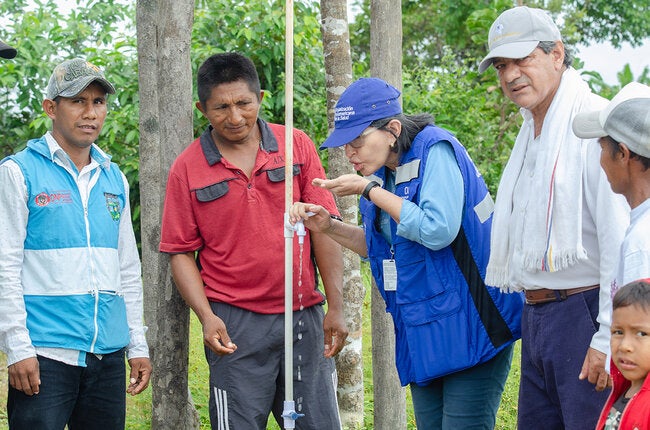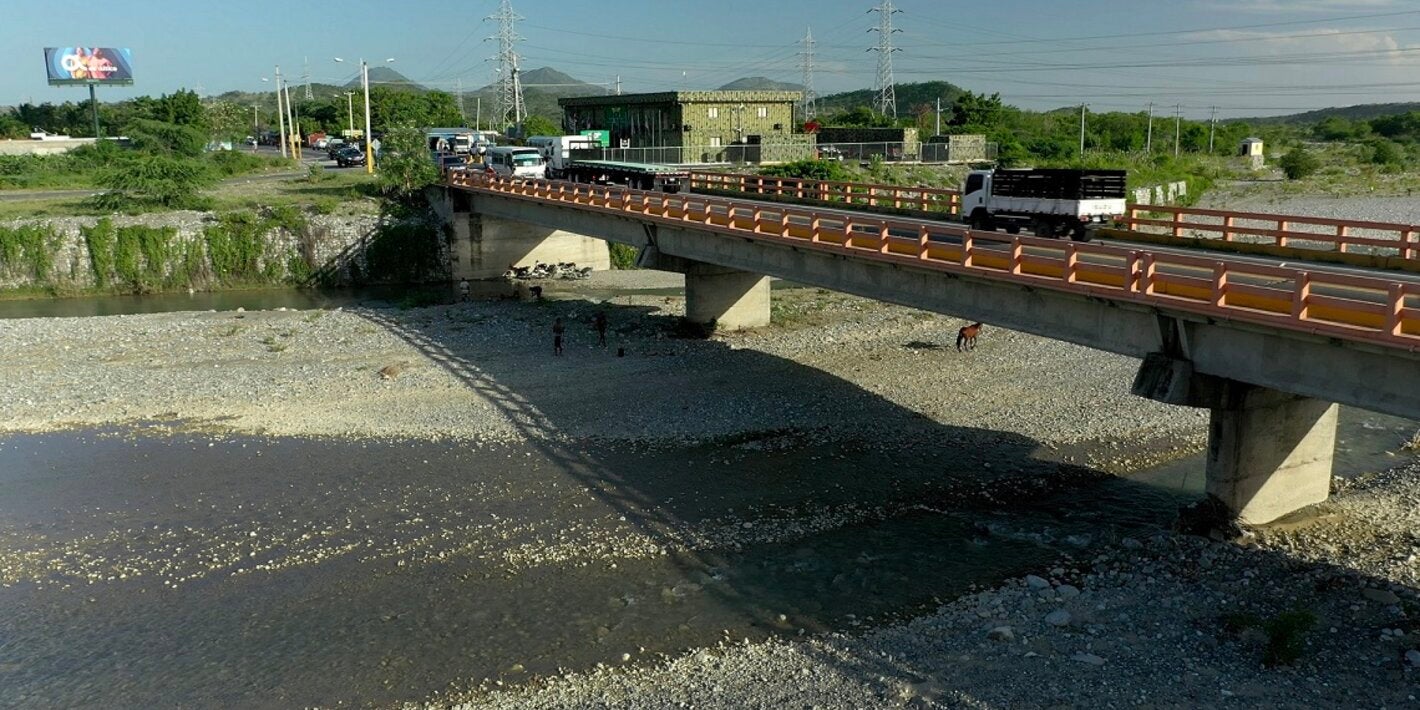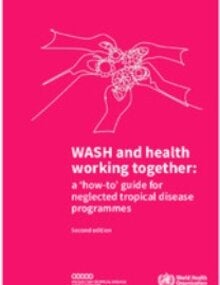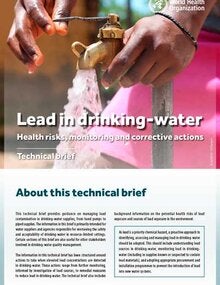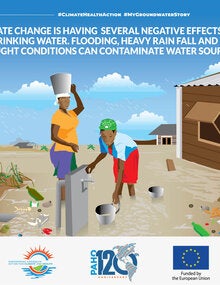Millones de personas en la Región de las Américas aún carecen de una fuente adecuada de agua potable e instalaciones seguras para la disposición y eliminación de las heces. Para 2030, si no se hacen un esfuerzo significativo, más de 132.7 millones de personas no podrán acceder a servicios de agua con gestión segura, 323.5 millones de personas no disponen de servicios de saneamiento gestionados de forma segura, y 7.4 millones practican aún defecación al aire libre (Ref:-inglés- Joint Monitoring Programe, JMP)
El Equipo Técnico Regional de Agua y Saneamiento (ETRAS), orienta su cooperación técnica con los países de la región de las Américas en acciones que contribuyan al logro de la gestión sostenible del agua y saneamiento para todos, a través del fortalecimiento de alianzas estratégicas para el cumplimiento del objetivo de desarrollo sostenible 6 (ODS6) en todos los contextos, incluyendo los establecimientos de salud (E.S.); fortalecimiento de capacidades locales, nacionales y regionales para la provisión de servicios de agua, saneamiento e higiene (WASH por sus siglas en inglés) gestionados de manera de segura; fortalecimiento de políticas y regulaciones para el abordaje integral de los elementos del marco de seguridad del agua y marco de seguridad del saneamiento; apoyo a la creación de sistemas nacionales de monitoreo de la calidad de los servicios de WASH y de su financiamiento como instrumento de gestión; acciones interprogramáticas para el abordaje de los determinantes ambientales de la salud en las estrategias de vigilancia y control de vectores y enfermedades infecciosas desatendidas; y fortalecimiento de las capacidades nacionales y regionales en la preparación y respuesta a situaciones de emergencias de salud pública y desastres y la gestión resiliente de los sistemas de agua potable y saneamiento tanto urbanos como rurales.
- El acceso a servicios inadecuados de agua, saneamiento e higiene tienen consecuencias importantes para asegurar la salud o la enfermedad de una población.
- La falta de servicios WASH favorece la transmisión de enfermedades infecciosas, como diarreas, infecciones respiratorias y otras enfermedades causadas por el uso del agua. El agua al estar contaminada con microrganismos y sustancias químicas causa malnutrición e intoxicaciones y limita la eliminación o el tratamiento de otras enfermedades desatendidas que padecen mayormente los grupos más vulnerables en la región.
- Aproximadamente 7.600 niños menores de 5 años mueren anualmente por enfermedades diarreicas en la Región. Los países, con mayores porcentajes de mortalidad por diarrea en niños menores de 5 años son: Haití (23%), Guatemala (10%), Bolivia (7%) y Venezuela (5%).
- Los establecimientos de salud con servicios WASH inadecuados, estarían empleando agua contaminada en atención a pacientes, limpieza hospitalaria, preparación de alimentos, lavado de instrumental etc, siendo más crítico en salas de maternidad, diálisis etc., esto favorece la propagación de infecciones intrahospitalarias y contaminación ambiental secundaria, tanto para el personal sanitario, como a los pacientes o visitantes de los establecimientos de salud.
Documentos relacionados:
- Informe GLAAS 2022 y los datos del ciclo 2021/2022 (disponible solo en inglés)
- Estadísticas Regionales de Agua Saneamiento e Higiene JMP 2025 (disponible solo en inglés)
•La cobertura de hogares con servicio de agua gestionado de manera segura es de apenas un 78.9%, los déficits en cuanto a cobertura y calidad de los servicios tienden a concentrarse en los grupos de bajos ingresos, grupos vulnerables y poblaciones rurales donde 4.45 millones de habitantes aún permanecen sin ningún tipo de servicio de provisión a agua potable. A esta situación, se suma la carencia de acceso de servicios adecuados de agua, saneamiento e higiene en Establecimientos de Salud.
•En los países de la región de las Américas, la calidad del agua es un factor limitante del acceso a un servicio gestionado de forma segura. Los sistemas de vigilancia de calidad del agua aún no registran como deberían, el indicador asociado a los ODS 6.1: “calidad de agua libre de contaminantes microbiológicos y químicos (prioritariamente arsénico y flúor)”.
•El saneamiento es un determinante importante de la Desnutrición Crónica Infantil; no obstante, entre 2014 y 2024 la cobertura regional de la población con servicios de agua saneamiento gestionado de manera segura en hogares ha pasado de 41.9 a apenas un 51.2%.
•El clima y otros cambios ambientales son algunos de los principales factores para que aparecieran o reaparecieran enfermedades transmitidas por vectores (ETV). Estos factores pueden expandir la distribución geográfica de las mismas y extender la temporada de transmisión, con lo que influyen en la morbilidad y mortalidad de estas enfermedades.
•El cambio climático afecta la prestación de servicios de agua y saneamiento; fenómenos extremos como sequías, inundaciones, deslizamientos y sismos entre otros, pueden reducir la disponibilidad del agua para consumo y afectar su calidad, dificultando su tratamiento, además de ocasionar daños la infraestructura, elevando los costos de operación y mantenimiento, además puede favorecer la propagación de enfermedades de transmisión hídrica o las transmitidas por vectores.
•Considerando cómo influyen los determinantes ambientales en la incidencia de enfermedades vectoriales, será necesario incorporar enfoques multisectoriales e integrales en las estrategias de vigilancia y control de vectores. Este mismo enfoque, debe ser implementado en el abordaje de las enfermedades infecciosas desatendidas.
Contribuir a la construcción de ciudades y comunidades ambientalmente más saludables y resilientes desde la perspectiva del manejo de los riesgos ambientales a la salud asociados con el agua, saneamiento e higiene. Para ello trabaja en el:
•Desarrollo de herramientas para fortalecer el trabajo colaborativo en el nivel local, con enfoque intersectorial en el abordaje de los determinantes ambientales de la salud.
•Desarrollo de contenidos técnicos para procesos de formación y capacitación del personal de salud, ambiente, vivienda, gestión de riesgos y prestación de servicios de agua y saneamiento entre otros, que tienen por objetivo desarrollar capacidades para responder a brotes y emergencias y la mejora en la gestión de riesgos relacionados.
•Fortalecimiento de los mecanismos de coordinación para la preparación y respuesta de los sectores salud y agua, saneamiento e higiene en emergencias y desastres.
•Apoyo técnico para desarrollar y fortalecer capacidades nacionales y locales para el abordaje de las enfermedades transmisibles y su acción en la comunidad.
Mejorar el desempeño de los programas de salud pública ambiental con énfasis en agua, saneamiento e higiene. En este sentido, la OPS:
•Brinda apoyo técnico a países para la alineación de las políticas públicas con el Objetivo de Desarrollo Sostenible 6.
•Promueve la generación de evidencia para una mejor gestión de los servicios de agua y saneamiento y el análisis de las cuentas financieras del sector, a través de la aplicación de herramientas como el GLAAS (Análisis Global de los Servicios de Agua y Saneamiento) y de TrackFin.
•Fortalece la capacidad técnica de los países, crea y difunde guías técnicas de agua, saneamiento e higiene.
•Apoya a los países en la difusión e inclusión de los principios de equidad y asequibilidad en la estimación de los indicadores del ODS 6 y en los instrumentos de planificación de los países, dando énfasis a la eliminación de la defecación al aire libre.
Contribuir a la construcción de un sector salud con infraestructuras y servicios de agua, saneamiento e higiene seguros; a través de:
•Generar espacios de discusión y análisis para generar consensos sobre el agua, saneamiento y la higiene en establecimientos de salud.
•Adaptar y difundir caja de herramientas de agua, saneamiento e higiene en establecimientos de salud, que incorpora el enfoque interprogramático con enfermedades infecciosas desatendidas, enfermedades infecciosas, calidad servicios de salud, seguridad del paciente, salud materno infantil y resistencia antimicrobiana, entre otros.
Fortalecer los sistemas de vigilancia de la salud pública ambiental en agua, saneamiento e higiene, así como el monitoreo del avance de los ODS. Para ello, la OPS:
•Desarrolla un sistema de monitoreo de los ODS 6.1, 6.2 y 6.3a en la Región alineado al Joint Monitoring Programe (JMP) e incorporación en los planes de agua y saneamiento.
•Ofrece Cooperación Técnica en el monitoreo y vigilancia de la calidad del agua en los países de América Latina y el Caribe.
Nuestros socios estratégicos:
- GIZ
- Naciones Unidas (UNICEF, PNUMA, OIT)
- AIDIS, Asociación interamericana de Ingeniería Sanitaria
- FIOCRUZ
Millions of people in the Region of the Americas still lack adequate sources of drinking water and safe facilities for the disposal and elimination of feces. It is estimated that in 2017, 28 million people in the Region lacked access to an improved water source, 83 million people lacked access to improved sanitation facilities, and 15.6 million still practiced open defecation (Ref: Joint Monitoring Program, JMP)
The Regional Technical Team on Water and Sanitation (ETRAS) gears its technical cooperation for countries in the Region of the Americas toward actions that facilitate sustainable management of water and sanitation for all by strengthening strategic partnerships to achieve Sustainable Development Goal 6 (SDG6) in all contexts, including health care facilities; by strengthening local, national, and regional capacity to provide safely managed water, sanitation, and hygiene (WASH) services; by strengthening policies and regulations for a comprehensive approach to the elements of a safely managed water and sanitation framework; by supporting the creation of national systems to monitor the quality of WASH services and their financing as a management tool; through interprogrammatic actions to address the environmental determinants of health in surveillance strategies to control vectors and neglected infectious diseases; and by improving national and regional preparedness and response capacity for public health and natural disaster emergencies.
- Inadequate access to water, sanitation, and hygiene services have significant consequences for the health of a population.
- Diseases related to the use of water include malnutrition, neglected diseases, diarrhea, and poisonings, among others. These are caused by micro-organisms and chemicals in drinking water.
- Approximately 7,600 children under 5 die annually from diarrheal diseases in the Region. The countries with the highest rates of mortality from diarrhea in children under 5 are Haiti (23%), Guatemala (10%), Bolivia (7%), and Venezuela (5%).
- Deficits in service coverage and quality tend to be concentrated in low-income groups, vulnerable groups, and rural populations. This is compounded by the lack of access to adequate water, sanitation, and hygiene services in health care facilities.
- Changes in vectors, climate, and the environment are some of the main factors that have led to the appearance or reappearance of vector-borne diseases (VBDs). These factors can expand the geographical distribution of such diseases and extend the transmission season, increasing the morbidity and mortality associated with these diseases.
- Considering how environmental determinants impact the incidence of vector-borne diseases, it will be necessary to incorporate multisectoral and integrated approaches into surveillance and vector control strategies. This same approach should be used to address neglected infectious diseases.
- In the countries of the Americas region, water quality is a limiting factor to access to a secure managed service. Water quality monitoring systems do not yet register as they should, the indicator associated with SDG 6.1: “water quality free of microbiological and chemical contaminants (primarily arsenic and fluorine)”.
- Sanitation is an important determinant of the Childhood Chronic Malnutrition, however, it is the service that has had the least progress during the past 10 years in the region, registering a difference of 43 percentage points between the population with access to water managed safely and population with sanitation managed safely.
PAHO is helping to improve the performance of environmental public health programs by emphasizing water, sanitation, and hygiene. In this matter:
- Provides technical support for countries to align public policies with Sustainable Development Goal 6.
- Promotes the generation of evidence for a better manage of water and sanitation services and review the financial accounts of the sector using tools such as GLAAS (Global Analysis and Assessment of Sanitation and Drinking Water) and TrackFin.
- Strengthens the technical capacity of countries. In addition, creates and disseminates technical guidelines on water, sanitation, and hygiene.
- Supports countries in the dissemination and inclusion of the principles of equity of affordability for the assessment of SDG 6 indicators and in the tool planning tools of countries, emphasizing in the open defecation elimination.
PAHO strengthens public health environmental surveillance systems for water, sanitation, and hygiene, and monitors progress toward achievement of the SDGs.
- Developing a system to monitor SDGs 6.1, 6.2, and 6.3a in the Region in accordance with the Joint Monitoring Program (JMP) and incorporating water and sanitation plans.
- Technical Cooperation in the monitoring and vigilance of the water quality in countries around Latin America and The Caribbean.
PAHO is helping to build a health sector infrastructure that includes safe water, sanitation, and hygiene services.
- Creating opportunities for discussion and analysis in order to build consensus around water, sanitation, and hygiene in health care facilities.
- Adapting and disseminating a toolkit for water, sanitation, and hygiene in health care facilities that takes an inter programmatic approach to neglected infectious diseases, quality in health facilities, patient safety, maternal and child health and antimicrobial resistance, among others.
PAHO is helping to build communities that are more environmentally healthy and resilient in terms of managing environmental risks to health associated with water, sanitation, and hygiene.
- Developing tools to strengthen collaborative work at the local level, with an intersectoral approach to addressing the environmental determinants of health.
- Developing technical content for the training and education of workers in health and other sectors (environment, housing, water and sanitation, etc.) in order to develop the capacity to respond to outbreaks and emergencies related to water, sanitation, and hygiene.
- Strengthening coordination mechanisms in the health sector and in the water, sanitation, and hygiene sector for emergency and disaster preparedness and response.
- Provides technical support to develop national and local capacity to address communicable diseases and their presence in the community.


